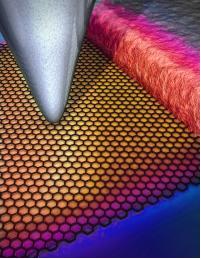Graphene transistors have a nanoscale cooling effect
April 4, 2011

An atomic force microscope tip scans the surface of a graphene-metal contact to measure temperature (credit: Alex Jerez, Beckman Institute for Advanced Science and Technology)
Researchers at the University of Illinois have found that graphene transistors have a nanoscale cooling effect that reduces their temperature.
The Illinois team used an atomic force microscope (AFM) tip as a temperature probe to make the first nanometer-scale temperature measurements of a working graphene transistor.
They found that thermoelectric cooling effects can be stronger at graphene contacts than resistive heating, actually lowering the temperature of the transistor. This self-cooling effect means that graphene-based electronics (built using carbon sheets one atom thick) could require little or no cooling, providing greater energy efficiency and increasing graphene’s attractiveness as a silicon replacement.
This also means that future computer chips made from graphene could be faster than silicon chips and operate at lower power.
Ref.: Eric Pop & William P. King et al., Nanoscale Joule heating, Peltier cooling and current crowding at graphene–metal contacts, April 3 online edition, Nature Nanotechnology